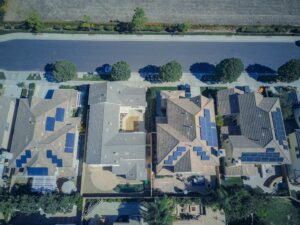Written by Riki Argyropoulou, junior surveyor at Wattcrop.
In the quest for a sustainable future, green architecture has emerged as a pivotal approach to reducing the environmental impact of buildings. At the forefront of this movement are photovoltaic (PV) systems, which harness the power of the sun to generate clean and renewable electricity. Integrating PV systems into green architecture not only offers numerous environmental benefits but also contributes to energy efficiency, resilience, and cost savings. This article explores the role of photovoltaic systems in green architecture, highlighting their significance, benefits, and the transformative potential they hold for sustainable building design.
The Significance of Photovoltaic Systems in Green Architecture:
Photovoltaic systems have revolutionized the field of green architecture by providing a renewable and reliable source of energy. By converting sunlight into electricity, PV systems play a crucial role in reducing reliance on fossil fuels, minimizing greenhouse gas emissions, and promoting sustainability. The integration of PV systems in green architecture embodies a commitment to environmental responsibility and paves the way for a sustainable future.
Benefits of Photovoltaic Systems in Green Architecture:
1. Energy Independence and Cost Savings: PV systems generate electricity on-site, reducing dependence on traditional energy sources and resulting in significant cost savings over time.
2. Carbon Footprint Reduction: By utilizing solar energy instead of fossil fuels, PV systems help to mitigate greenhouse gas emissions, making buildings more environmentally friendly and sustainable.
3. Energy Efficiency and Net-Zero Buildings: Integrating PV systems into green architecture allows for the creation of energy-efficient buildings, and in some cases, net-zero energy buildings, where the energy generated by the PV system matches or exceeds the building’s energy consumption.
4. Resilience and Energy Security: PV systems offer a decentralized energy generation solution, providing a reliable source of electricity during power outages and increasing the resilience of buildings in the face of natural disasters or grid disruptions.
5. Long-Term Sustainability: PV systems have a long lifespan and require minimal maintenance, making them a durable and sustainable energy solution for green buildings.
Integration of Photovoltaic Systems in Green Architecture:
1. Rooftop Installations: PV panels can be installed on rooftops, maximizing the use of available space and minimizing the visual impact of the system.
2. Building-Integrated Photovoltaics (BIPV): PV technology can be seamlessly integrated into building elements such as facades, windows, and shading devices, merging functionality with architectural design.
3. Solar Parks and Open Spaces: Large-scale PV installations in solar parks or on open land provide opportunities for renewable energy generation on a community or regional scale.
4. Smart Grid Integration: PV systems can be interconnected with smart grid technologies, allowing for efficient energy management and optimized use of renewable energy within buildings and the larger grid network.
Overcoming Challenges and Expanding Possibilities:
While PV systems in green architecture offer numerous benefits, there are challenges to address and opportunities to explore:
1. Design Considerations: Architects and designers need to carefully integrate PV systems into building designs to ensure optimal orientation, shading analysis, and aesthetic harmony.
2. Energy Storage and Grid Integration: The integration of energy storage solutions, such as batteries, allows for better management of energy flow and increased self-consumption of PV-generated electricity.
3. Cost and Affordability: Continued research and development, along with supportive policies and incentives, are crucial to driving down the cost of PV systems and making them more accessible to a wider range of projects.
4. Technological Advancements: Ongoing innovations in PV technology, such as new materials, higher conversion efficiencies, and flexible designs, hold the potential for further improving the performance and integration of PV systems in green architecture.

Photovoltaic systems have become indispensable in the realm of green architecture, enabling buildings to operate sustainably, efficiently, and independently. By harnessing the power of the sun, PV systems provide renewable energy, reduce carbon footprints, and contribute to the resilience and cost savings of green buildings. The integration of PV systems into green architecture is a testament to our commitment to a sustainable future, where buildings not only minimize their environmental impact but actively contribute to a cleaner and more resilient energy landscape. As technology advances and awareness grows, the role of photovoltaic systems in green architecture will continue to expand, paving the way for a greener, more sustainable built environment.


